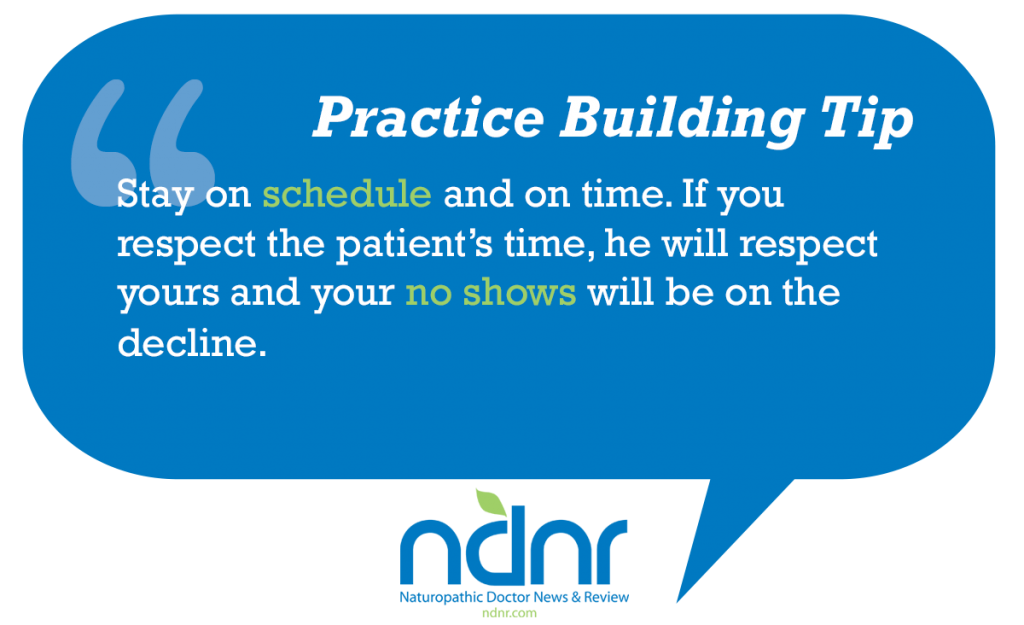Judy Capko
Missed appointments are frustrating for any practice and you pay a big price for the no show patient or the 11th-hour cancellation. For naturopathic physicians who can dedicate an hour or more for many appointments, the costs can be staggering.
It begins with the time it takes to schedule the appointment, complete the pre-appointment paperwork, pull and review the chart and then follow up with the patient to reschedule the appointment. The lost revenue is an even bigger issue.
Let’s say your average charge for a patient visit is $150 and there are 3 no shows each day. The lost revenue is likely to be more than $80,000 a year. You can’t afford to absorb this kind of a loss. So what can you do to stop it and improve patient compliance?
First, stay on schedule and on time. If you respect the patient’s time, he will respect yours and your no shows will be on the decline. Begin each day with a morning huddle with the office staff. This takes less than 10 minutes and can help to address potential flow problems before they emerge.
Next, study your scheduling template to be sure you are allowing enough time for each patient, based on appointment type. If the practice tends to run behind, it’s time to get realistic and evaluate the amount of time that should be allocated for each patient. Recognize that new patients take more time, ask them to come in early, and dedicate more time on the schedule. Never schedule new patients back-to-back. It’s a sure-fire way to get behind.
When it comes to those annual physicals or that periodic exam for the patients with chronic problems, many practices have improved efficiency and patient service by scheduling a follow-up summary visit to review the results of studies ordered the day of the exam and to dedicate quality time to discuss the treatment plan and cement the patient’s commitment to complying with your recommendations. Alternatively, you could order preliminary tests to be performed prior to the patient’s visit so you have the results on hand at the time of the exam.
Next, work in real time. Chart your patient visits as you go and read your phone messages throughout the day – responding to clinical calls promptly by delegating to your assistant when possible. Efficiency gains can be made by taking the time to train staff properly on what intake information should be obtained in advance. This really helps doctors to stay on schedule.
Now examine patient access to make sure it is sufficient to meet patient demands. Start by looking to see when the next 3 available appointments are. If that third one must wait more than a week to get in, you are not reserving enough time on the schedule to meet patient needs. In this case you’ll want to examine the previous month’s appointment schedule to determine the average number of new patients, established visits, and work-ins. Then build your template accordingly. For instance, if you usually see 5 new patients a day, block time for 6 a day to allow for growth.
Finally, train staff to reinforce the importance of keeping a scheduled appointment to patients. Start by setting up a confirmation system that tells a patient that she not only has a scheduled appointment, but that you are expecting her and it is important that she keep the appointment. The first time a patient misses an appointment, remind them how serious it is and let them know not only that you reserved a specific time slot, but there’s a possibility another patient had to wait longer to get in because you were holding the slot. You must reaffirm that missed appointments are not acceptable in your practice.
A well-managed appointment system makes for a happier staff, happier patients and better care. At the same time you are able to meet patient demands, accomplish more in a day, and improve productivity and service.
 Judy Capko is a healthcare consultant and author of the runaway best-selling book: Secrets of the Best Run Practice, now in its 2nd edition. She is also the author of Take Back Time – Bringing time management to medicine. With more than 25 years experience, her focus is practice operations, staffing, finance and marketing.
Judy Capko is a healthcare consultant and author of the runaway best-selling book: Secrets of the Best Run Practice, now in its 2nd edition. She is also the author of Take Back Time – Bringing time management to medicine. With more than 25 years experience, her focus is practice operations, staffing, finance and marketing.





